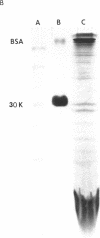Abstract
Certain strains of Staphylococcus aureus associated with toxic shock syndrome elaborate material that induces human blood monocytes to secrete interleukin-1 (IL-1). IL-1 was detected both by its ability to cause fever in rabbits using the leukocytic pyrogen (LP) assay and by its mitogenic activity towards thymocytes in the so-called lymphocyte-activating factor (LAF) assay. Anti-human IL-1 prevents the manifestation of both activities. Filtrates of control strains of S. aureus manifest neither activity. Thus, culture filtrates derived from toxic shock syndrome (TSS)-associated strains cause biphasic fever in rabbits when injected intravenously. The fever lasts several hours. Plasma taken at the peak of the fever and injected into a second set of rabbits produces a brief monophasic fever typical of LP. Further, human monocytes release LP when incubated with TSS filtrates in vitro. The monocyte products also stimulate the proliferation of mouse thymocytes in the presence of phytohemagglutinin in a manner characteristic of LAF. A bacterial filtrate is much less effective without an intermediate incubation with monocytes. The stimulation of monocyte IL-1 production is easily quantified, provides a simple method of assaying the TSS toxin, and since it involves human cells, is directly relevant to the human disease. The assay was used to monitor the purification of TSS toxin. Only 0.1 ng/ml of the purified material is required to induce monocyte IL-1 production. It is thus more potent than endotoxin. In contrast to endotoxin, its effect is not blocked by polymyxin B. We conclude that in TSS the sudden fever and probably other components of the acute phase response may be attributed to a massive release of IL-1.
Full text
PDF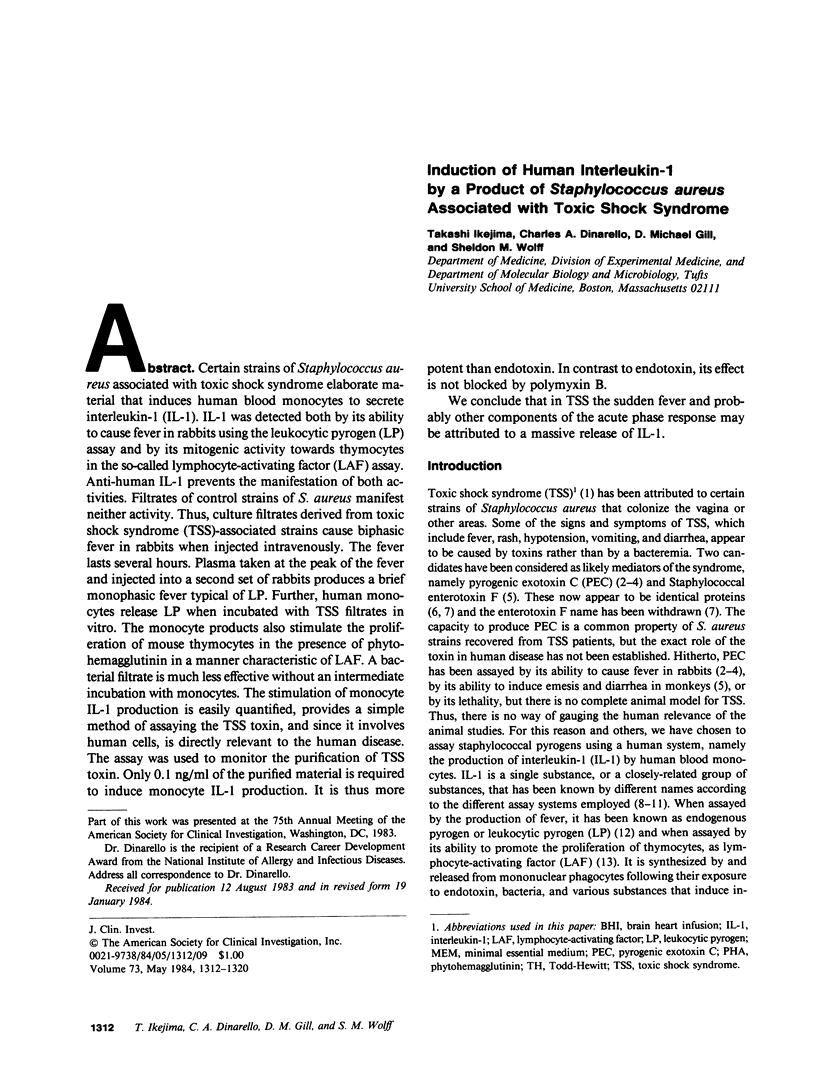
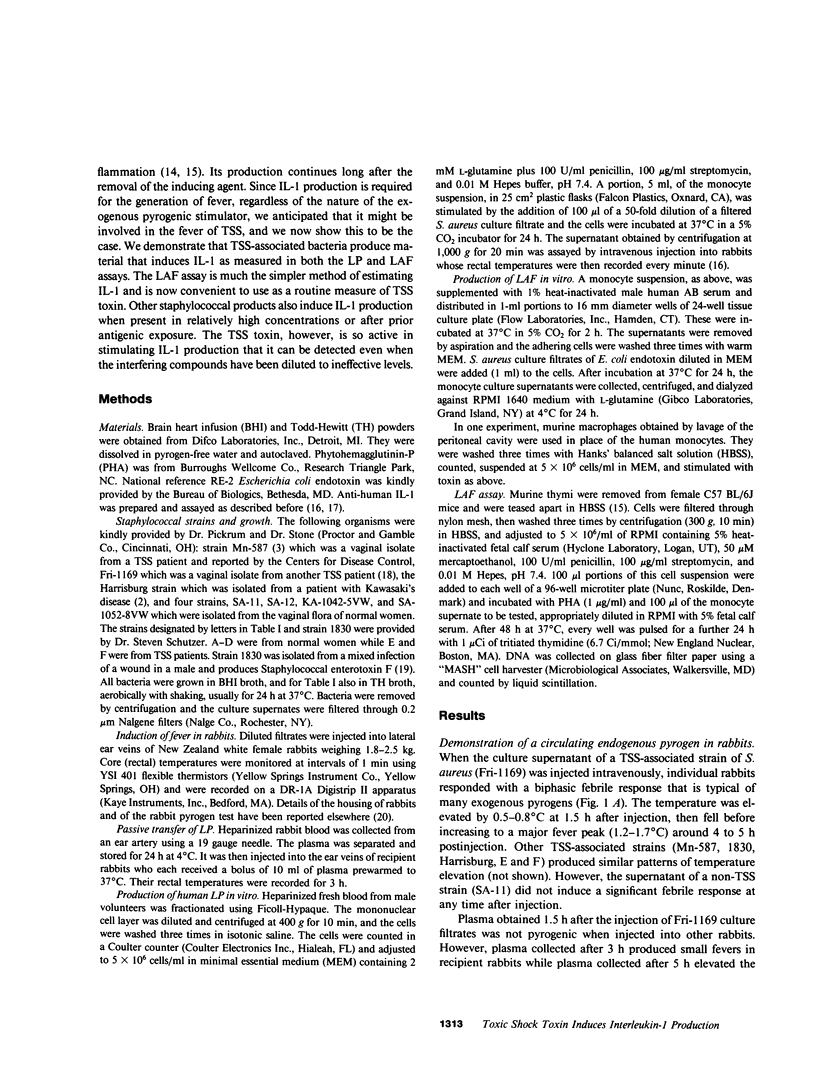
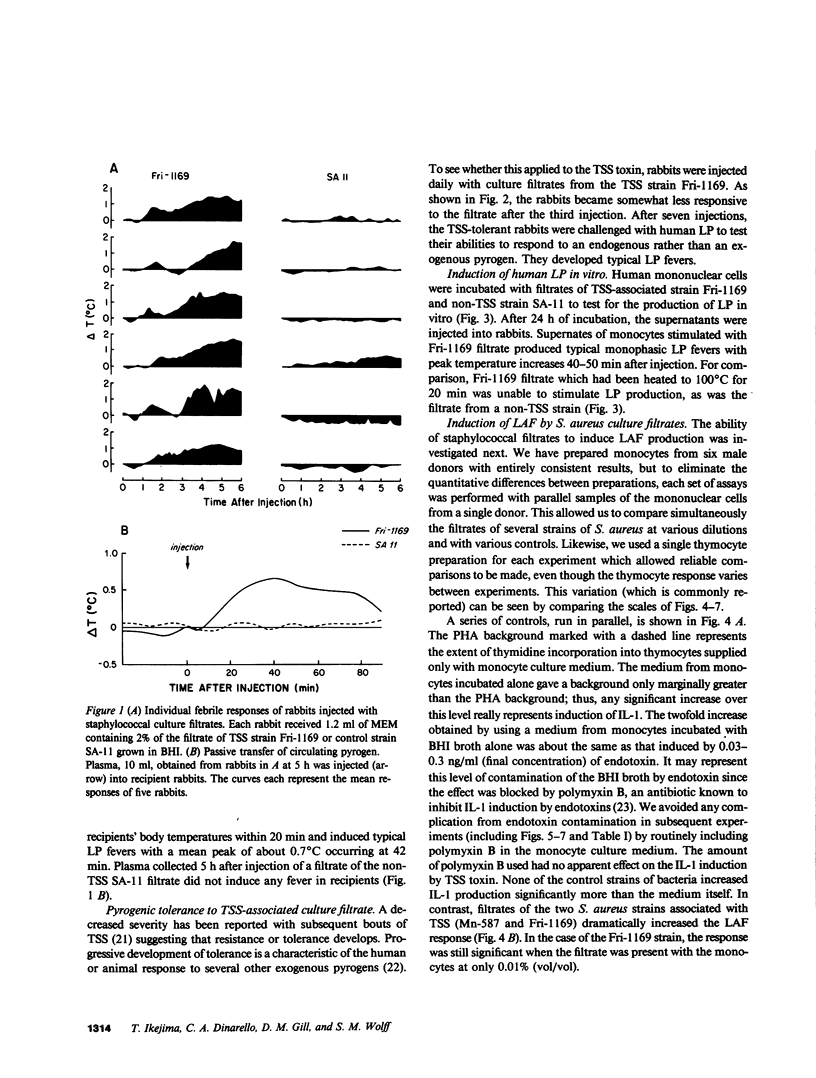
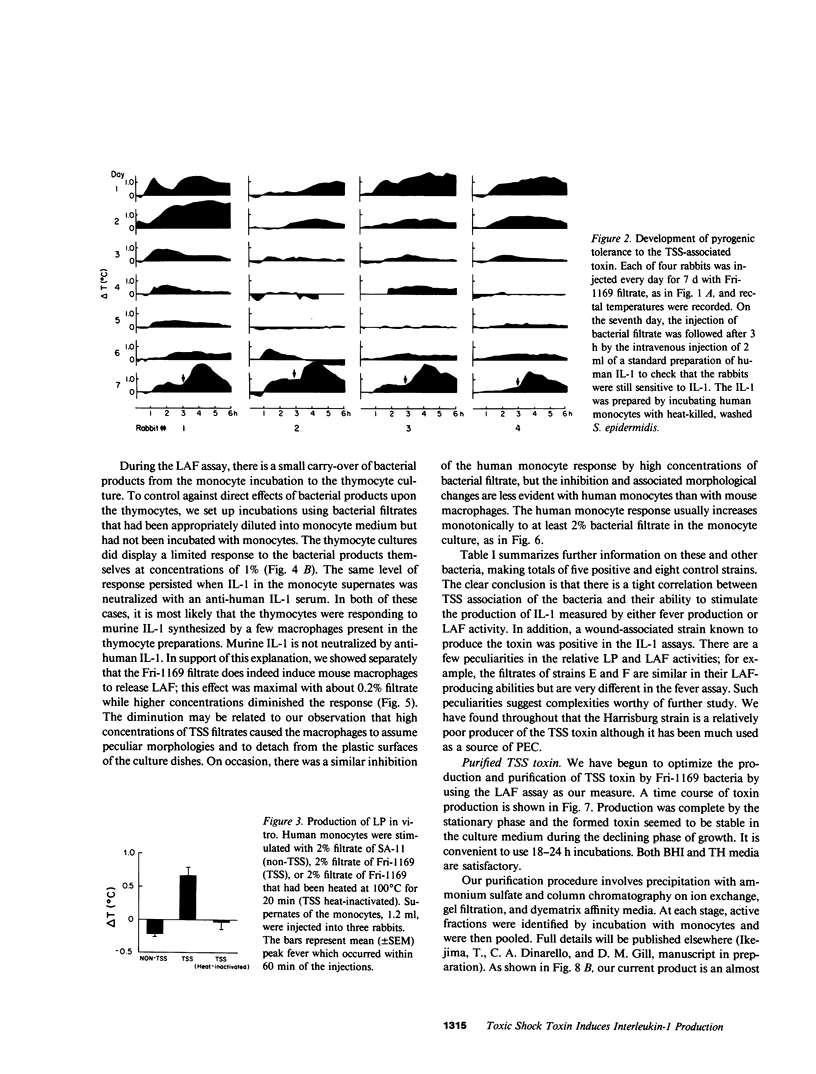
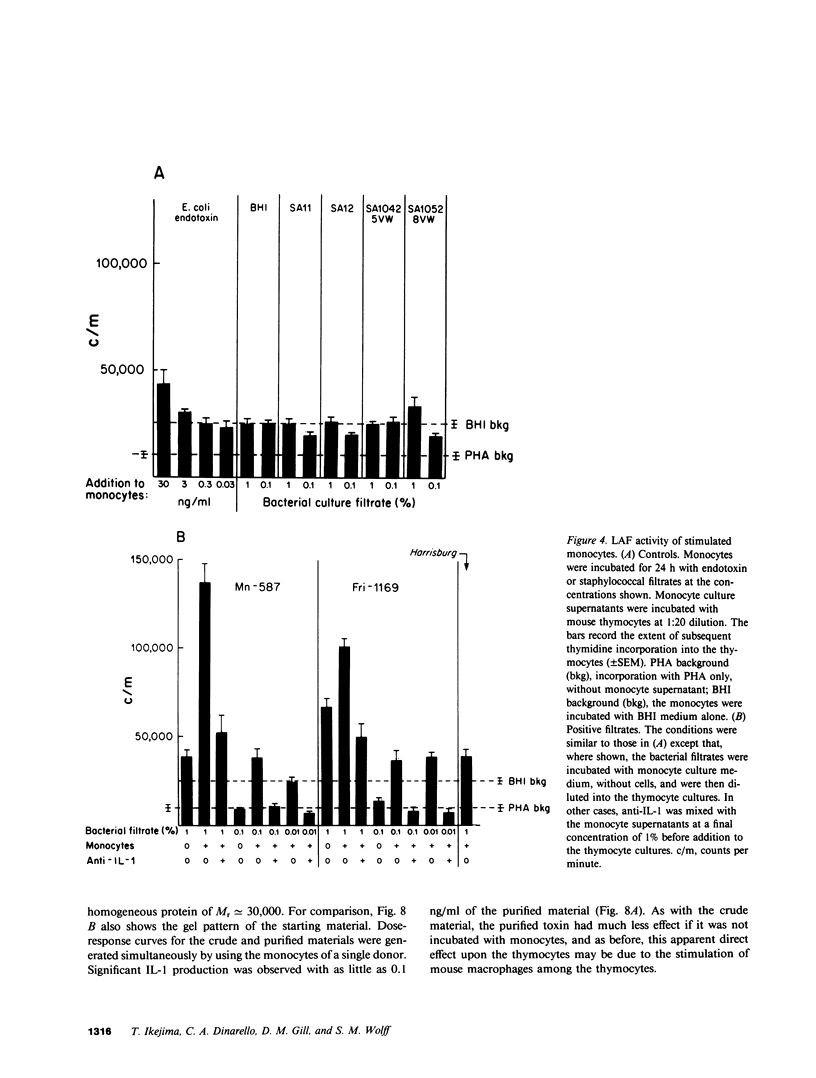
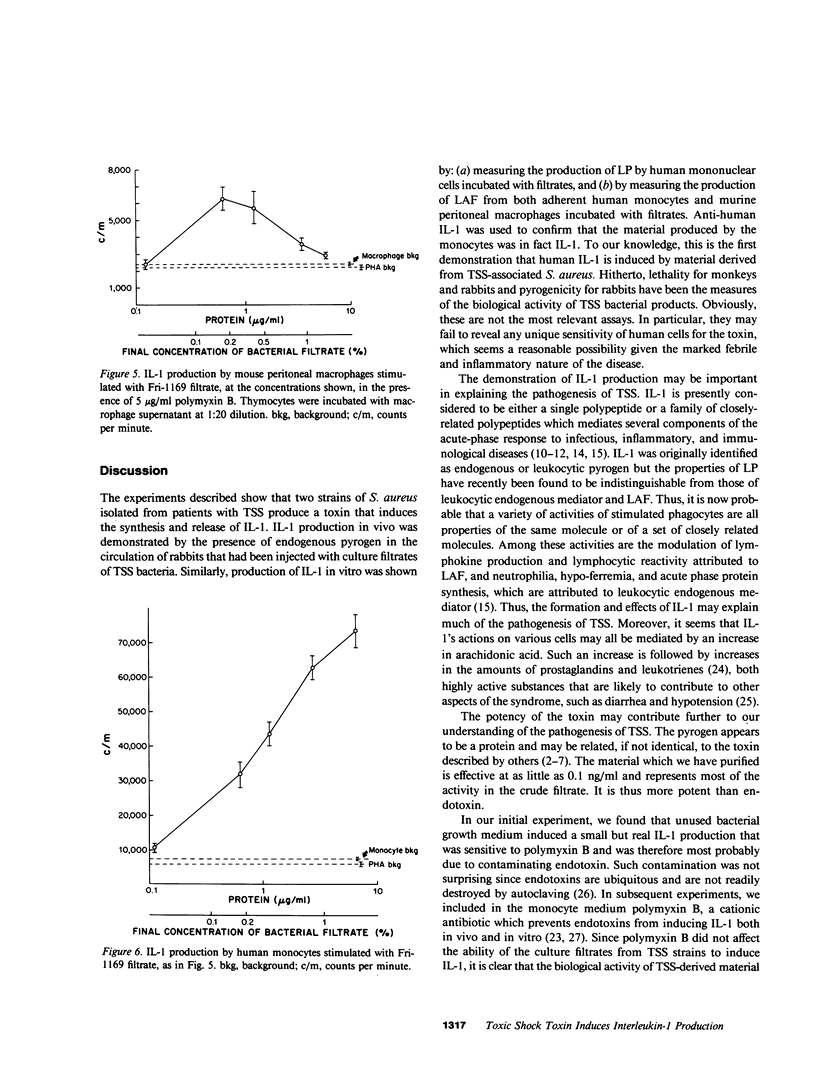
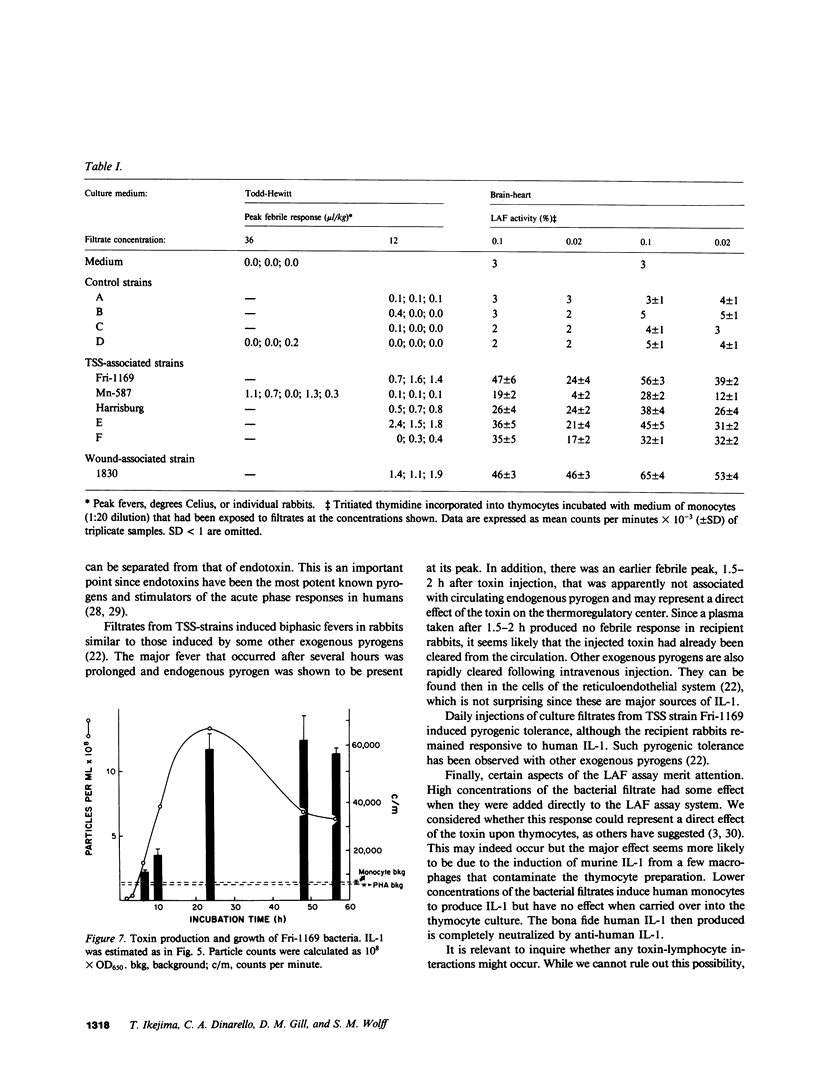
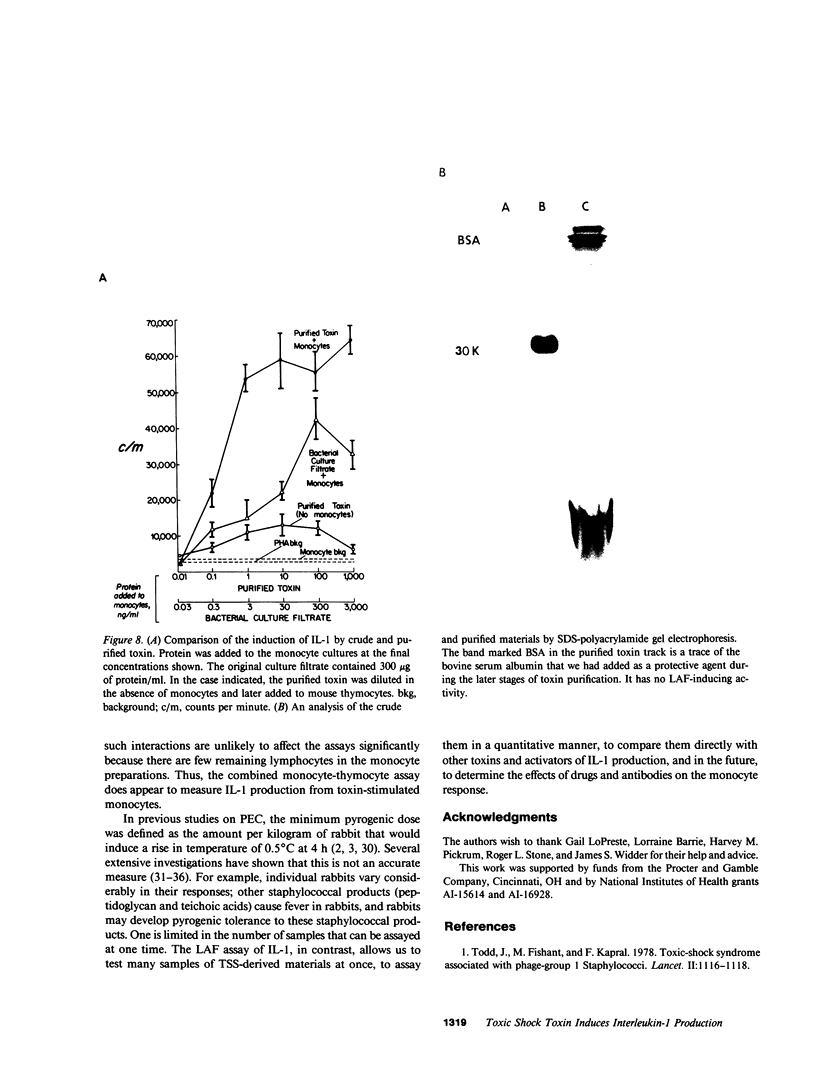
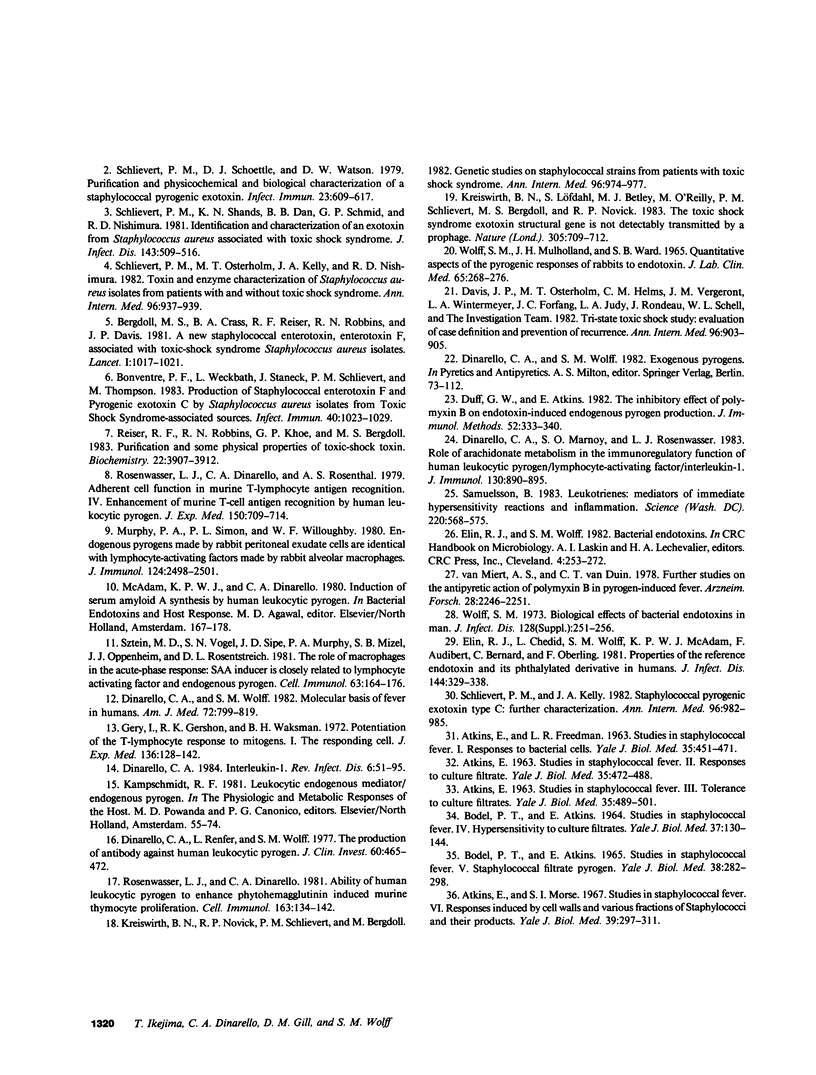
Images in this article
Selected References
These references are in PubMed. This may not be the complete list of references from this article.
- ATKINS E., FREEDMAN L. R. STUDIES IN STAPHYLOCOCCAL FEVER. I. RESPONSES TO BACTERIAL CELLS. Yale J Biol Med. 1963 Jun;35:451–471. [PMC free article] [PubMed] [Google Scholar]
- ATKINS E. STUDIES IN STAPHYLOCOCCAL FEVER. II. RESPONSES TO CULTURE FILTRATES. Yale J Biol Med. 1963 Jun;35:472–488. [PMC free article] [PubMed] [Google Scholar]
- ATKINS E. STUDIES IN STAPHYLOCOCCAL FEVER. III. TOLERANCE TO CULTURE FILTRATES. Yale J Biol Med. 1963 Jun;35:489–503. [PMC free article] [PubMed] [Google Scholar]
- Atkins E., Morse S. I. Studies in staphylococcal fever. VI. Responses induced by cell walls and various fractions of staphylococci and their products. Yale J Biol Med. 1967 Apr;39(5):297–311. [PMC free article] [PubMed] [Google Scholar]
- BODEL P. T., ATKINS E. STUDIES IN STAPHYLOCOCCAL FEVER. IV. HYPERSENSITIVITY TO CULTURE FILTRATES. Yale J Biol Med. 1964 Oct;37:130–144. [PMC free article] [PubMed] [Google Scholar]
- Bergdoll M. S., Crass B. A., Reiser R. F., Robbins R. N., Davis J. P. A new staphylococcal enterotoxin, enterotoxin F, associated with toxic-shock-syndrome Staphylococcus aureus isolates. Lancet. 1981 May 9;1(8228):1017–1021. doi: 10.1016/s0140-6736(81)92186-3. [DOI] [PubMed] [Google Scholar]
- Bodel P. T., Atkins E. Studies in staphylococcal fever. V. Staphlococcal filtrate pyrogen. Yale J Biol Med. 1965 Dec;38(3):282–298. [PMC free article] [PubMed] [Google Scholar]
- Bonventre P. F., Weckbach L., Staneck J., Schlievert P. M., Thompson M. Production of staphylococcal enterotoxin F and pyrogenic exotoxin C by Staphylococcus aureus isolates from toxic shock syndrome-associated sources. Infect Immun. 1983 Jun;40(3):1023–1029. doi: 10.1128/iai.40.3.1023-1029.1983. [DOI] [PMC free article] [PubMed] [Google Scholar]
- Dinarello C. A. Interleukin-1. Rev Infect Dis. 1984 Jan-Feb;6(1):51–95. doi: 10.1093/clinids/6.1.51. [DOI] [PubMed] [Google Scholar]
- Dinarello C. A., Marnoy S. O., Rosenwasser L. J. Role of arachidonate metabolism in the immunoregulatory function of human leukocytic pyrogen/lymphocyte-activating factor/interleukin 1. J Immunol. 1983 Feb;130(2):890–895. [PubMed] [Google Scholar]
- Dinarello C. A., Renfer L., Wolff S. M. The production of antibody against human leukocytic pyrogen. J Clin Invest. 1977 Aug;60(2):465–472. doi: 10.1172/JCI108797. [DOI] [PMC free article] [PubMed] [Google Scholar]
- Dinarello C. A., Wolff S. M. Molecular basis of fever in humans. Am J Med. 1982 May;72(5):799–819. doi: 10.1016/0002-9343(82)90548-4. [DOI] [PubMed] [Google Scholar]
- Duff G. W., Atkins E. The inhibitory effect of polymyxin B on endotoxin-induced endogenous pyrogen production. J Immunol Methods. 1982 Aug 13;52(3):333–340. doi: 10.1016/0022-1759(82)90005-9. [DOI] [PubMed] [Google Scholar]
- Elin R. J., Wolff S. M., McAdam K. P., Chedid L., Audibert F., Bernard C., Oberling F. Properties of reference Escherichia coli endotoxin and its phthalylated derivative in humans. J Infect Dis. 1981 Oct;144(4):329–336. doi: 10.1093/infdis/144.4.329. [DOI] [PubMed] [Google Scholar]
- Gery I., Gershon R. K., Waksman B. H. Potentiation of the T-lymphocyte response to mitogens. I. The responding cell. J Exp Med. 1972 Jul 1;136(1):128–142. doi: 10.1084/jem.136.1.128. [DOI] [PMC free article] [PubMed] [Google Scholar]
- Kreiswirth B. N., Löfdahl S., Betley M. J., O'Reilly M., Schlievert P. M., Bergdoll M. S., Novick R. P. The toxic shock syndrome exotoxin structural gene is not detectably transmitted by a prophage. Nature. 1983 Oct 20;305(5936):709–712. doi: 10.1038/305709a0. [DOI] [PubMed] [Google Scholar]
- Kreiswirth B. N., Novick R. P., Schlievert P. M., Bergdoll M. Genetic studies on Staphylococcal strains from patients with toxic shock syndrome. Ann Intern Med. 1982 Jun;96(6 Pt 2):974–977. doi: 10.7326/0003-4819-96-6-974. [DOI] [PubMed] [Google Scholar]
- Murphy P. A., Simon P. L., Willoughby W. F. Endogenous pyrogens made by rabbit peritoneal exudate cells are identical with lymphocyte-activating factors made by rabbit alveolar macrophages. J Immunol. 1980 May;124(5):2498–2501. [PubMed] [Google Scholar]
- Reiser R. F., Robbins R. N., Khoe G. P., Bergdoll M. S. Purification and some physicochemical properties of toxic-shock toxin. Biochemistry. 1983 Aug 2;22(16):3907–3912. doi: 10.1021/bi00285a028. [DOI] [PubMed] [Google Scholar]
- Rosenwasser L. J., Dinarello C. A. Ability of human leukocytic pyrogen to enhance phytohemagglutinin induced murine thymocyte proliferation. Cell Immunol. 1981 Sep 1;63(1):134–142. doi: 10.1016/0008-8749(81)90034-4. [DOI] [PubMed] [Google Scholar]
- Rosenwasser L. J., Dinarello C. A., Rosenthal A. S. Adherent cell function in murine T-lymphocyte antigen recognition. IV. Enhancement of murine T-cell antigen recognition by human leukocytic pyrogen. J Exp Med. 1979 Sep 19;150(3):709–714. doi: 10.1084/jem.150.3.709. [DOI] [PMC free article] [PubMed] [Google Scholar]
- Samuelsson B. Leukotrienes: mediators of immediate hypersensitivity reactions and inflammation. Science. 1983 May 6;220(4597):568–575. doi: 10.1126/science.6301011. [DOI] [PubMed] [Google Scholar]
- Schlievert P. M., Kelly J. A. Staphylococcal pyrogenic exotoxin type C: further characterization. Ann Intern Med. 1982 Jun;96(6 Pt 2):982–986. doi: 10.7326/0003-4819-96-6-982. [DOI] [PubMed] [Google Scholar]
- Schlievert P. M., Osterholm M. T., Kelly J. A., Nishimura R. D. Toxin and enzyme characterization of Staphylococcus aureus isolates from patients with and without toxic shock syndrome. Ann Intern Med. 1982 Jun;96(6 Pt 2):937–940. doi: 10.7326/0003-4819-96-6-937. [DOI] [PubMed] [Google Scholar]
- Schlievert P. M., Schoettle D. J., Watson D. W. Purification and physicochemical and biological characterization of a staphylococcal pyrogenic exotoxin. Infect Immun. 1979 Mar;23(3):609–617. doi: 10.1128/iai.23.3.609-617.1979. [DOI] [PMC free article] [PubMed] [Google Scholar]
- Schlievert P. M., Shands K. N., Dan B. B., Schmid G. P., Nishimura R. D. Identification and characterization of an exotoxin from Staphylococcus aureus associated with toxic-shock syndrome. J Infect Dis. 1981 Apr;143(4):509–516. doi: 10.1093/infdis/143.4.509. [DOI] [PubMed] [Google Scholar]
- Sztein M. B., Vogel S. N., Sipe J. D., Murphy P. A., Mizel S. B., Oppenheim J. J., Rosenstreich D. L. The role of macrophages in the acute-phase response: SAA inducer is closely related to lymphocyte activating factor and endogenous pyrogen. Cell Immunol. 1981 Sep 1;63(1):164–176. doi: 10.1016/0008-8749(81)90037-x. [DOI] [PubMed] [Google Scholar]
- Todd J., Fishaut M., Kapral F., Welch T. Toxic-shock syndrome associated with phage-group-I Staphylococci. Lancet. 1978 Nov 25;2(8100):1116–1118. doi: 10.1016/s0140-6736(78)92274-2. [DOI] [PubMed] [Google Scholar]
- WOLFF S. M., MULHOLLAND J. H., WARD S. B. QUANTITATIVE ASPECTS OF THE PYROGENIC RESPONSE OF RABBITS TO ENDOTOXIN. J Lab Clin Med. 1965 Feb;65:268–275. [PubMed] [Google Scholar]
- van Miert A. S., van Duin C. T. Further studies on the antipyretic action of polymyxin B in pyrogen-induced fever. Arzneimittelforschung. 1978;28(12):2246–2251. [PubMed] [Google Scholar]



